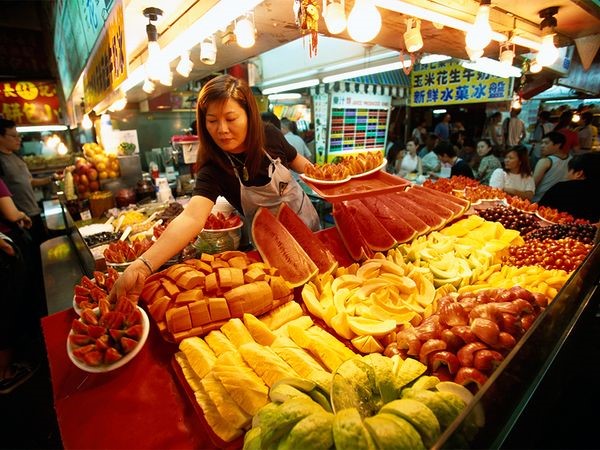Best Trips 2015
November, 19, 2014National Geographic Traveler presents the New Year's must-see places. Whether it’s India’s literary hub or Switzerland’s mountain majesty, these 20 go-now destinations will send you packing.

Taiwan
Photograph by Yang Liu, Corbis
Out of China's Shadow
As China gets mightier and smoggier, Taiwan feels calmer and cleaner. When China restricted access to the internet, Taiwan provided free Wi-Fi islandwide. When China marginalized its ethnic groups, Taiwan reintroduced indigenous Formosan languages to schools. Taiwan ranks in the top 50 (out of 178) on the Environmental Performance Index (EPI), while China sank to the 118th spot.
But Taiwan is much more than China’s contrarian runaway bride. The sweet-potato-shaped island—a tad smaller than Switzerland (but no less mountainous)—has a high-tech global urban sector and a thriving aboriginal society. In one decade, "Made in Taiwan" went from being a sign of bad quality to a national statement of pride.
Skyscraper-filled capital Taipei, with a population of seven million, has been named 2016’s World Design Capital. A flurry of new buildings opens in 2015, including a performing arts center designed by Rem Koolhaas's firm.
More than anything, Taipei lives up to its reputation as a food paradise. “Forget about breakfast at the hotel,” says Peray, a popular Taipei food blogger. “In the early mornings, at food stalls, you can get clay oven rolls, charcoal grill sandwiches, rice with chicken, and rice noodle soup with pork. The challenge here is staying hungry.” —Adam H. Graham
Travel Tips
When to Go: Fifteenth day of the first lunar month, Taiwan Lantern Festival, Nantou; mid-April to mid-June, Mondays and Thursdays, Penghu Ocean Fireworks Festival, Magong City; Mid-July to late August, Keelung Midsummer Ghost Festival, Keelung City; October 2014-January 2015, Taiwan Hot Spring and Fine-Cuisine Carnival, multiple locations
How to Get Around: Traveling by train is the best, and most affordable, option. The Taiwan Railways system (not Taiwan High Speed Rail) loops all the way around Taiwan, making it possible (with transfers) to visit most regions. Train stops are typically located near downtown areas. In Taipei, use the Taipei Rapid Transitcity metro.
Where to Stay: Indulge in a moonlit, mineral springs bath at the Hotel Royal Chiaohsi, a minimalist contemporary retreat located in the countryside about 18 miles south of the New Taipei City border. Both Western and Japanese rooms and suites (featuring beds and layered tatami mats, respectively) are available. Try both styles in the Complex suite, a Western-Japanese hybrid with sliding wall dividers creating two separate sleeping areas. Take the hotel shuttle from the Chiaohsi train station (advance reservations required).
Where to Eat or Drink: Snack your way through Taipei’s ubiquitous street food markets, such as Shida Night Market and Raohe Street Tourist Night Market. Vendors hawk all manner of irresistible xiao chi (small eats), including xiaolongbao(steamed dumplings), pan-fried bao (buns), mochi (rice balls), braised pork, and the Taiwanese go-to snack: deep-fried—and pungent—stinky tofu.
What to Buy: Shop for Chinese medicinal herbs; textiles and fabrics; and tea, dried fruits, and candy in the storefronts lining Taipei’s Dihua Street. A commerce center since the 1850s, Dihua Street has been significantly spruced up in recent years, yet it retains its traditional Taiwanese vibe and original architecture—a historical hodgepodge of mainly single-story Fujian-style homes and neo-baroque buildings constructed during the Japanese colonial period (1895-1945).
Cultural Tip: Smiling and using two Mandarin phrases—xiexie (thank you, pronounced “sheh sheh”) and ni hao (good day, pronounced “NEE how”) is a good way to feel more at home.
What to Read Before You Go: Although Zhuoliu Wu’s autobiographical novel Orphan of Asia (Columbia University Press, paperback English translation, 2008) was completed at the end of Japanese colonial rule in 1945, his insights into Taiwanese identity remain relevant and provide a frame of reference for some current Asian tensions.
Helpful Links: Tourism Bureau M.O.T.C. Republic of China (Taiwan) and Taiwan Tourism Bureau
Fun Fact: A free eco-guesthouse powered by solar energy and the contributions of community volunteers welcomed its first guests in late 2014. Opened on a trial basis, the two-story Sun Self Hotel in Taipei City was designed by Japanese artist Jun Kitazawa. Guests help collect energy to power the hotel’s electricity by wheeling a cart equipped with solar cells as they tour the surrounding neighborhood.
Insider Tip From Adam H. Graham: The Shilin Night Market is wildly popular with tourists. Perhaps too popular. To really get to know Taiwanese night market food, go to less touristy ones like Ningxia Road Night Market, where you can sample octopus balls, geoduck clams, oyster omelets, and pig's blood cake with locals.
http://www.nationalgeographic.com/travel/best-trips-2015/#/food-market-taipei_85221_600x450.jpg

